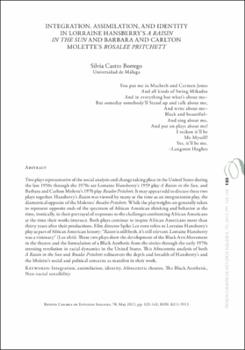Integration, Assimilation, and Identity in Lorraine Hansberry’s a Raisin in the Sun and Barbara and Carlton Molette’s Rosalee Pritchett
Fecha
2015Resumen
La obra de teatro escrita por Lorrain Hansberry, A Raisin in the Sun, estrenada en Broadway en 1959, y la obra de Carlton y Barbara Molette titulada Rosalee Pritchett, estrenada en 1970, son representativas del cambio y análisis social que aconteció en los Estados Unidos a finales de los años cincuenta y en las décadas de los años sesenta y setenta. A primera vista el análisis de estas dos obras en apariencia tan dispares puede resultar extraño, ya que Raisin fue visto por muchos como representante del teatro integracionista de finales de los cincuenta, mientras que Rosalee Pritchett era una obra separatista. Sin embargo, ambas obras tienen un nexo de unión y es que las dos ofrecen respuesta a los retos a los que se enfrentaban los Afro Americanos en este período histórico. El presente artículo analizará la temática de ambas obras teatrales desde una perspectiva Afrocéntrica, por su relevancia política y social que aún hoy sirve de inspiración a dramaturgos norteamericanos contemporáneos. Two plays representative of the social analysis and change taking place in the United States during the late 1950s through the 1970s are Lorraine Hansberry’s 1959 play A Raisin in the Sun, and Barbara and Carlton Molette’s 1970 play Rosalee Pritchett. It may appear odd to discuss these two plays together. Hansberry’s Raisin was viewed by many at the time as an integrationist play, the diametrical opposite of the Molettes’ Rosalee Pritchett. While the playwrights are generally taken to represent opposite ends of the spectrum of African American thinking and behavior at the time, ironically, in their portrayal of responses to the challenges confronting African Americans at the time their works intersect. Both plays continue to inspire African Americans more than thirty years after their productions. Film director Spike Lee even refers to Lorraine Hansberry’s play as part of African American history: “Raisin is still fresh, it’s still relevant. Lorraine Hansberry was a visionary” (Lee xlvii). These two plays show the development of the Black Arts Movement in the theatre and the formulation of a Black Aesthetic from the sixties through the early 1970s stressing revolution in racial dynamics in the United States. This Afrocentric analysis of both A Raisin in the Sun and Rosalee Pritchett rediscovers the depth and breadth of Hansberry’s and the Molette’s social and political concerns as manifest in their work.





